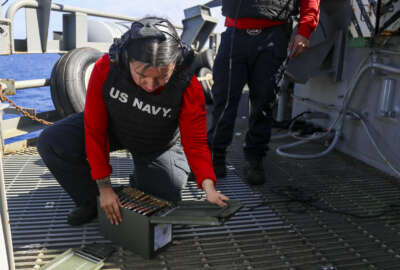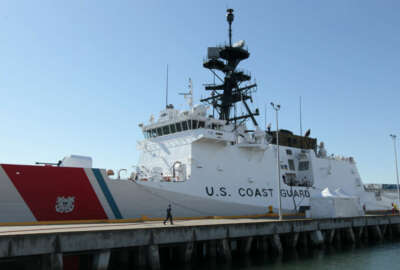
Navy sets up new command to help with flailing recruiting numbers
The military has a recruiting problem. That fact has been on display in the past couple months as all of the military services bolster enlistment bonuses and...
Best listening experience is on Chrome, Firefox or Safari. Subscribe to Federal Drive’s daily audio interviews on Apple Podcasts or PodcastOne.
The military has a recruiting problem. That fact has been on display in the past couple months as all of the military services bolster enlistment bonuses and reevaluate their end strength goals for 2022 and 2023.
The Navy is by no means exempt from the issue, and as of May was 1.5% below its authorized end strength. Now, in response, the service is taking the formal step of creating a new command to address at least some of its recruiting issues.
Navy Recruiting Reserve Command (NRRC) will hit operating status in September and focus on informing already active duty sailors about their options to join the Navy Reserve.
“The challenge that has affected us all is the competition for our military and civilian talent, and that of our reserve market,” said Capt. Karen Muntean, commander of NRRC. “This competitive employment market has forced us to think about short and long term organizational structures that make sense.”
NRRC is part of Navy Recruiting Command’s larger reorganization. It is shifting from a three geographic region model — east, central and west — to two — east and west. The realignment frees resources to create NRRC to focus specifically on the retention of sailors who are already enlisted and encouraging them to join the reserves after they leave.
The Navy says a big part of its restructure focus is on canvasser recruiters, who are the face of the service to potential recruits. They talk to potential sailors, hand out flyers, do home visits and assist in transitions to the military.
The command will also work closely with the Navy’s 26 talent acquisition groups (NTAGs).
“The NTAGs are a strong partner with a shared role in supporting the Navy Reserve,” said Muntean. “While the prior service recruiters will realign from the NTAG to NRRC, the NTAG will continue to provide the administrative support to those sailors who remain in their local area of responsibility. NRRC is a zero-sum build of Operational Control and the NTAGs will retain the administrative control where the support structure already exists for the sailors previously assigned to them. The relationship with our Navy Recruiting Regions and NTAGs is an integral part of our command structure and the interdependence will be in place for the foreseeable future. Future state discussions include a desire to have Reserve Talent Acquisition Groups, which would be an NRRC extension of leadership and support to our sailors.”
NRRC will bring in recruiters from NTAGs to build new transition teams for the command focused on the reserve lifestyle.
The Navy and military are finding that they need to change the way the recruit and expand their options in order to hit end strength targets.
The Navy already changed its policy to allow soldiers to delay separation or retirement and it increase reenlistment bonuses for certain occupations.
The Army is hurting the most for service members. It has already reframed its end strength for 2022 down from 485,000 to between 445,000 and 455,000.
The Army announced in July that it is starting a preparatory course in hopes of sharpening potential soldiers’ skills to succeed in basic training.
“The course will help prospective soldiers overcome barriers to service,” Lt. Gen. Maria Gervais, deputy commanding general of Army Training and Doctrine Command, said. “The course will invest in individuals so they can overcome obstacles and serve our nation. The course will allow recruits who meet all other qualifications for enlistment, a path to service. The young men and women who will personally participate in this pilot have the desire to improve themselves and want to honorably serve their country.”
Copyright © 2024 Federal News Network. All rights reserved. This website is not intended for users located within the European Economic Area.
Scott Maucione is a defense reporter for Federal News Network and reports on human capital, workforce and the Defense Department at-large.
Follow @smaucioneWFED





